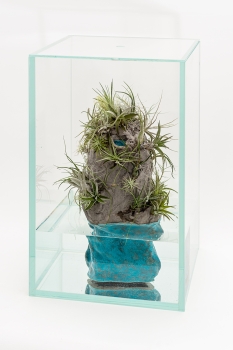Phantominsel Antilia
2022
Glastank, Keramik, Raumduft "ein Tag am Meer", Tildansien
Glass tank, ceramic, room fragrance "a day by the sea", Tildansien
Masse: H 70 x B 35 x T 35 cm ( H 27,6 x B 13,8 x T 13,8 inch )
„Antilia“ ist der Werktitel einer Insel aus der dreiteiligen Werkgruppe „Phantominseln“. Die Insel aus Keramik steht im Wasser und ist mit über 20 verschieden Arten Luftpflanzen oder Tillandsien bewachsen. Ein kleine blaue Insellagune ist für den Duft des Raumes verantwortlich. Wie die Insel, hat auch der Duft modellcharakter, es ist ein herkömmlicher Raumduft namens „Ein Tag am Meer“. Dieser synthetische Duft mischt sich mit dem natürlichen Duft der Pflanzen, die auf der Skulptur wachsen.
Inseln und damit verknüpfte utopische, exotische, idyllische und erotische Assoziationen spielen in der Literatur- und Kunstgeschichte ebenso wie in der Sprache eine grosse Rolle. Die Insel steht für den Sehnsuchtsort schlechthin. Der Fluchtpunkt dieses Sehnsuchtsortes ist offenbar die Identifikation der Insel mit dem Ursprung und Zuständen eines irdischen Paradieses. Die Insel steht für einen romantisierten Ort der Ruhe und Abgeschiedenheit – ein Gegenpol zu unseren hektischen, dicht besiedelten Städten.
„Antilia“ kann als Modell für die idealisierte Vorstellung des Fleckens unberührter Natur Mitten im blauen Meer gelesen werden. Der synthetische Raumduft hat nichts oder nur wenig mit den natürlichen Gerüchen des Meeres gemein. Der Raumduft ist harmlos, ohne Charakter und wirkt künstlich fremd.
Die Skulptur kann aber auch im Kontext des Klimawandels gelesen werden. Mit dem ansteigenden Meeresspiegel werden nach und nach ganze Inselstaaten im Meer versinken und haben damit einiges mit den Phantominseln gemeinsam. Zwar hat es dann diese Inseln einmal gegeben, aber irgendwann werden die Karten neu überarbeitet und die Inseln werden darauf verschwinden, wie es bei den Phantominseln geschah.
*
"Antilia" is the title of an island from the three-part work group "Phantom Islands". The ceramic island stands in the water and is overgrown with more than 20 different species of air plants or tillandsias. A small blue island lagoon is responsible for the fragrance of the room. Like the island, the fragrance has a model character, it is a conventional room fragrance called "A Day at the Sea". This synthetic scent mixes with the natural scent of the plants growing on the sculpture.
Islands and the utopian, exotic, idyllic and erotic associations associated with them play a major role in the history of literature and art as well as in language. The island stands for the place of longing par excellence. The vanishing point of this place of longing is apparently the identification of the island with the origin and conditions of an earthly paradise. The island stands for a romanticised place of peace and seclusion - an antithesis to our hectic, densely populated cities.
"Antilia" can be read as a model for the idealised idea of the spot of untouched nature in the middle of the blue sea. The synthetic room scent has little or nothing in common with the natural smells of the sea. The room scent is harmless, without character and seems artificially alien.
But the sculpture can also be read in the context of climate change. As sea levels rise, entire island states will gradually sink into the sea and thus have something in common with the phantom islands. It is true that these islands once existed, but at some point the maps will be revised and the islands will disappear on them, as happened with the phantom islands.

